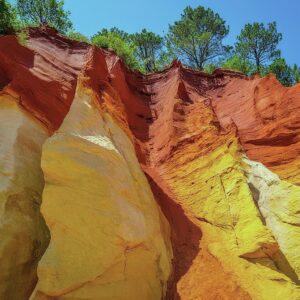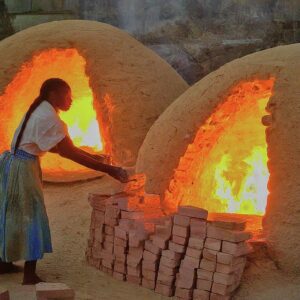Introduction
In the artist’s palette, subtle variations in color can evoke vastly different moods and atmospheres. Yellow Ochre, Raw Sienna, and Burnt Sienna are three pigments that share warm earthy tones yet possess distinct characteristics and applications. Understanding the differences between these hues can enrich an artist’s repertoire and offer new avenues for creative expression.
Yellow Ochre:
- A landscape showcasing a naturally exposed iron oxide-rich clay formation in shades of yellow, reminiscent of the source material for yellow ochre pigment.

Yellow ochre is a pigment renowned for its golden-yellow hue with subtle earthy undertones. It is derived from natural clay deposits rich in hydrated iron oxide, giving it a warm and inviting appearance reminiscent of sun-kissed landscapes. Artists have long prized yellow ochre for its versatility and lightfastness, making it suitable for a wide range of applications.
- Color: Golden-yellow with earthy undertones.
- Origins: Derived from natural clay deposits containing hydrated iron oxide.
- Characteristics: Versatile, lightfast, and stable over time.
- Applications: Used as a base color, for mixing greens, and for creating warm highlights in landscapes and still life paintings.
Raw Sienna:
- A scene of miners extracting reddish-brown earth from an open pit mine, symbolizing the raw sienna pigment’s origins.

Raw sienna possesses a warm, earthy hue reminiscent of sun-baked terracotta. It is sourced from natural clay deposits, much like yellow ochre, but undergoes minimal processing to retain its raw, natural appearance. Raw sienna’s gentle warmth and subtle tonal variations make it a popular choice for artists seeking to capture the essence of autumnal landscapes and rustic scenes.
- Color: Warm, earthy brown with yellow undertones.
- Origins: Sourced from natural clay deposits rich in iron oxide.
- Characteristics: Natural, earthy, and subtly warm in tone.
- Applications: Ideal for underpainting, glazing, and creating warm, earthy tones in landscapes, portraits, and still life compositions.
Burnt Sienna:
- A depiction of kilns firing clay rich in iron oxides, transforming it into the deeper, richer hues of burnt sienna pigment.

Burnt sienna, in contrast to its raw counterpart, undergoes a transformation through heat treatment, resulting in deeper, reddish-brown tones. This process alters the chemical structure of the pigment, enhancing its richness and intensity while imbuing it with a distinctive warmth and depth. Burnt sienna is prized by artists for its versatility and ability to evoke a sense of depth and drama in paintings.
- Color: Deep reddish-brown with warm undertones.
- Origins: Derived from natural sienna clay through heat treatment.
- Characteristics: Rich, warm, and vibrant; exhibits strong tinting strength.
- Applications: Used for creating shadows, glazes, and warm, earthy tones in landscapes, portraits, and still life compositions.
Have a look at one of my paintings that uses the earth tone colors to give that warmth look.

Conclusion
Yellow ochre, raw sienna, and burnt sienna are three pigments that offer a diverse range of hues, each with its own unique characteristics and applications. From the golden warmth of yellow ochre to the earthy richness of raw sienna and the deep intensity of burnt sienna, these pigments provide artists with a versatile palette for capturing the beauty and complexity of the natural world. By understanding the differences between these colors, artists can effectively utilize them to inspire their works with depth, warmth, and vibrancy.
PS: If you want to fast track your learning in painting, you can browse through the online courses here
https://courses.worldofpaintings.com/s/store


